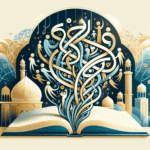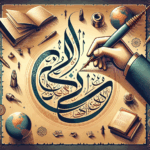The Arabic Alphabet: A Bridge Between East and West
Have you ever wondered how something as simple as an alphabet can connect cultures and histories across continents? 🌍 The Arabic alphabet is more than just a set of characters; it’s a powerful bridge linking the East and the West. In this blog post, we’ll explore the fascinating journey of the Arabic alphabet and its impact on various aspects of global culture and communication.
Table of Contents
1. Introduction to the Arabic Alphabet
2. Historical Journey of the Arabic Alphabet
3. The Alphabet’s Influence on Language and Culture
4. Modern-Day Applications and Significance
5. Conclusion
6. FAQs
Introduction to the Arabic Alphabet
The Arabic alphabet, a script used by over 420 million people worldwide, is known for its beautiful and flowing script. It’s not just a means of communication but an art form that has influenced calligraphy everywhere. The alphabet consists of 28 letters and is written from right to left, a unique feature that gives it a distinct aesthetic.
Historical Journey of the Arabic Alphabet
The Arabic alphabet has its roots in the Nabataean script, which was used in the Arabian Peninsula around the 4th century CE. As Islam spread across the Middle East and beyond, the Arabic script followed, becoming the writing system for languages like Persian, Urdu, and even Turkish until the 20th century. This expansion turned the Arabic alphabet into a vital cultural link between different regions. 🕌
The Alphabet’s Influence on Language and Culture
The influence of the Arabic alphabet extends beyond language. In medieval times, it played a crucial role in preserving and transmitting knowledge. Many scientific, mathematical, and philosophical texts were written in Arabic, making it a key language of scholarship. The script’s aesthetic appeal also contributed to the development of unique artistic traditions, including intricate calligraphy and architectural designs. 🎨
Modern-Day Applications and Significance
Today, the Arabic alphabet continues to be a significant cultural and educational tool. It’s used in various modern technologies, from digital fonts to mobile applications, bridging the gap between tradition and innovation. Moreover, learning the Arabic alphabet has become increasingly popular in Western countries, where people are keen to understand the language and culture more deeply. 📱
Conclusion
The Arabic alphabet is more than just a writing system; it’s a cultural bridge that connects diverse histories and societies. By understanding its history and influence, we can appreciate its role in fostering communication and mutual respect between the East and the West.
FAQs
1. Why is the Arabic alphabet written from right to left?
The right-to-left direction is a traditional writing method that dates back to the early Semitic scripts, which influenced the development of the Arabic script.
2. How many letters are in the Arabic alphabet?
The Arabic alphabet consists of 28 letters.
3. What are some languages that use the Arabic alphabet?
Besides Arabic, languages like Persian, Urdu, and Pashto use the Arabic script, often with slight modifications to accommodate specific sounds.
4. Is it hard to learn the Arabic alphabet?
While the Arabic script may seem challenging at first, with practice, many find it to be a rewarding and enriching experience.
5. How has the Arabic alphabet influenced Western art?
The Arabic script’s calligraphic beauty has inspired Western artists and designers, influencing various art forms, including architecture and graphic design.





